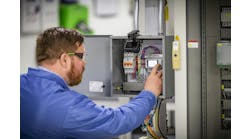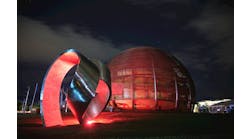With the advancement of motor control and construction, the operational difference between servo motors and stepper motors has become minimal. Theoretically, a servo motor can move to an infinitely small fraction of a rotational degree, whereas a stepper motor is limited by the number of individual stator windings that create each step. Practically, these limitations do not exist.
In general, a servo motor is just a part of a servo system. The system consists of a motor, a drive and a feedback device.
The drive, or amplifier, takes the incoming ac power and rectifies it to supply a dc voltage to the drive circuitry. The drive can be a simple rectifier with power relays controlled by external control circuitry. This type of drive relies on the external control device to perform all of the motor-control functions such as speed, acceleration, PID tuning and so forth. Intelligent drives are also available from most manufacturers that allow motion profiles to be stored, fault conditions to be detected and auto-tuning of the PID loop. For these intelligent drives, a simple digital interface, such as EtherNet/IP, may be all that is required from the central control device.
The feedback device may be an absolute encoder or resolver. An encoder outputs a pattern of electrical signals that represent the servo motor’s position. In the encoder housing, various electronic components are combined to read an angular position based typically on slots in a metal disk or masked areas of a glass or plastic disk. A resolver is a rotary transformer that changes the measurement of current through two stator windings. A resolver’s only moving part is the rotor. This makes a resolver more rugged than an encoder. In operation, the control device, either an intelligent drive or the primary control device, continually compares the commanded position with the measured position and adjusts the motor current or voltage accordingly.
A servo motor may be designed to be an ac or dc voltage style motor. The motor must be properly paired with the drive. The drive then supplies the correct type of voltage and current. The ac style motors are often preferred in constant speed applications. They require less maintenance because they have no brushes to wear out and can reach much higher rpm than the dc style. The dc motors are often preferred in variable-speed applications and require a simpler control system.
Stepper motors also require some type of drive to control motion. As with servo systems, stepper-system drives can be simple pulse generators up to entirely independent intelligent drives. Many stepper systems run in open-loop mode. There is no direct feedback to the control system. If the load is constant, such as with an x-y table or conveyor lane diverters, as long as the motor is sized correctly, a stepper motor can operate in open-loop mode. If the load is dynamic and correct positioning is essential, a feedback device can be added to the motor shaft.
As with servo drives, stepper drives can be simple or complex. Stepper drives are typically powered with 24 Vdc, but other voltages are available. Stepper systems do not need to be tuned the way that servo systems do. Using an intelligent drive will reduce the control system complexity. Intelligent drives are also available from most manufacturers that allow motion profiles to be stored and fault conditions to be detected.
Stepper motors produce high torque at low speed; however, if the commanded speed is too low, the motor may exhibit excessive vibrations. A natural resonance occurs around 200 Hz. Usually, the starting speed is much higher than 200 Hz, so resonance should not be a problem. Vibration at low or no load is also an issue with stepper motors. Careful selection of the motor is essential to avoid vibration. As the motors increase in speed, the output torque decreases. At speeds above 1000 rpm, stepper motors begin to lose their performance.
Servo systems can cost up to three times the price of a comparable stepper system. If the system load remains relatively constant and the operational speed falls within the range supported by a stepper system, it is worth evaluating. Knowing the mechanical characteristics the system will be operating under is one of the most important factors in developing a good design.
If you are just beginning to design motion systems, make use of the manufacturer’s technical support. Local support is usually the best place to start. If the local application engineer can’t answer a question, ask for a contact at the manufacturer’s corporate level. You might be advised to purchase the drive unit, the motor and the feedback device from the same manufacturer. A person can surely save some money by using different parts from different manufacturers and by building your own cables. However, in the event you need to have a representative from one of the manufacturers come in to assist in fixing a problem, the trouble will always be with the equipment from the other manufacturer.




